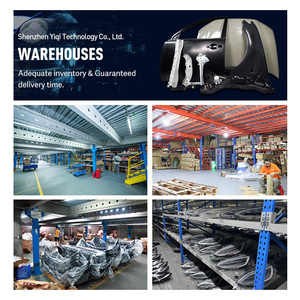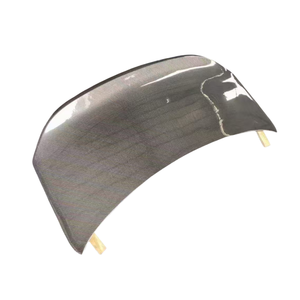(14891 products available)















































































































































































































A car trunk lid is a rear-end closure. The car trunk lid is also known as a trunk lid, boot lid, and deck lid. Auto parts trunk lids are available in different types:
Type of trunk lid
The trunk lid is a type of car trunk lid. It is a cover and seal for the trunk. This type of trunk lid is designed for all types of cars. However, the trunk lids of sedans are more obvious. Trunk lids can be closed with external handles or internal handles. Car models that have trunk lids include: sedans, hatchbacks, coupes, and roadsters.
Type of trunk lid design
Trunk lids are designed with different designs. These designs include: conventional, hinged at the top; reverse, hinged at the bottom; gullwing, which opens upward; and scissor, which lifts up vertically.
Type of trunk lid construction
The trunk lid is constructed using different materials. These materials include: steel, aluminum, composite, and glass. Steel is a common material for the construction of trunk lids. It is used for affordable models. The trunk lid of luxury and sports cars is made of aluminum. This is because aluminum is lightweight and corrosion-resistant. Glass trunk lids are used in hatchback cars to provide visibility to the rear. They also allow for easy access to the trunk. Composite material is durable. It is used to reduce the weight of the trunk lid.
Auto parts trunk lids specifications vary depending on the make and model of a car. Here are some general specifications to consider.
Size and Dimension
Trunk lids come in various sizes and dimensions depending on the vehicle's design. Measurements include the width, length, and curvature of the trunk lid. These specifications are essential for proper fitting and alignment with the trunk body.
Material
Different trunk lids are made of different materials, such as steel, aluminum, and composite materials. Steel lids are durable and sturdy, offering excellent protection. Aluminum lids are lightweight and resistant to corrosion. Composite materials are used in electric vehicles and are lighter and more resistant to corrosion.
Weight
The weight of a trunk lid is a significant consideration in vehicle design. Heavy lids may require strong gas struts for lifting. At the same time, lightweight lids reduce the overall weight of the vehicle, improving fuel efficiency and speed.
Opening Mechanism
Trunk lids have various opening mechanisms depending on the design and model of the vehicle. Common opening mechanisms include external handles, internal levers, and electronic buttons. Some trunk lids may have key locks for additional security.
Seals and Weatherproofing
Weatherproofing seals are fitted along the edges of the trunk lid to ensure a proper seal when the trunk is closed. These seals prevent water and air from entering the trunk. Weatherproofing seals are made from durable weather-resistant materials like rubber.
Struts and Supports
Gas struts and supports are important components of trunk lids. They assist in opening the trunk lid and keeping it open when lifted. These struts provide support and ensure the trunk lid closes tightly. They are fitted along the inner sides of the trunk lid.
Trunk Lid Spoilers
Some trunk lids have spoilers fitted on the surface. These spoilers improve the vehicle's aerodynamics by reducing drag. Spoilers also enhance the vehicle's aesthetics.
Maintaining an auto parts trunk lid is important for ensuring it operates well and lasts long. Here are some maintenance tips.
Choosing the right parts and accessories for the car trunk can be difficult because there are many options available. Here are some tips to help retailers choose auto parts trunk lids that will meet their customers' needs.
Trunk lid replacement can be a straightforward process, depending on the model and make of the car. Here are some general steps that can be followed when replacing auto parts trunk lids:
Q1: What are the materials used in the Auto parts trunk lids?
A1: Typically, trunk lids are made from three materials: steel, aluminum, and composite materials. Steel is the most common material used in trunk lids because it is durable and cost-effective. It is suitable for ordinary vehicles. However, it is heavy and may rust when exposed to moisture. On the other hand, aluminum trunk lids are lighter and resistant to rust. They are suitable for electric cars and high-performance vehicles. Lastly, composite materials, which are a combination of different materials, are ideal for modern vehicles. They have the advantage of all the materials combined.
Q2: What is the difference between a trunk lid and a trunk tailgate?
A2: Trunk lid and trunk tailgate are two terms that are often used interchangeably. However, in most cases, the trunk lid refers to the vehicles' upper section of a three-section car body that covers the trunk area. On the other hand, a trunk tailgate is a type of trunk lid that is hinged at the bottom and is accessible from the rear of the vehicle. In many vehicles, the trunk lid and tailgate are the same, and both terms can be used to refer to the same part.
Q3: Why is the trunk lid damaged?
A3: Like any other part of the vehicle, the trunk lid can be damaged. One of the main causes of trunk lid damage is accidents, where the trunk lid can be dented. Other physical impacts, such as falling objects, can also cause trunk lid damage. Moreover, wear and tear over time can cause parts of the trunk lid to fall apart. Corrosion can also cause the trunk lid to be damaged, where rust eats away the material. Improper maintenance, such as failing to lubricate the hinges, can also cause trunk lid damage.
Q4: How is a trunk lid damage assessed?
A4: Visual inspection is the primary way to assess trunk lid damage. This is where the technician inspects the trunk lid to assess the extent of the damage. Another method is to use a measuring tool to measure the extent of distortion of the trunk lid. This method is commonly used when the trunk lid is damaged by an accident. A diagnostic tool is used to assess the damage in cases where the trunk lid prevents the vehicle from closing, or it is misaligned.
Q5: What is the trunk lid seal?
A5: A trunk lid seal is a seal around the trunk lid to prevent water, dust, and dirt from entering the trunk. It also ensures that the trunk lid is closed tightly and securely. The seals are usually made of rubber and foam to withstand the pressure of the trunk lid closing.